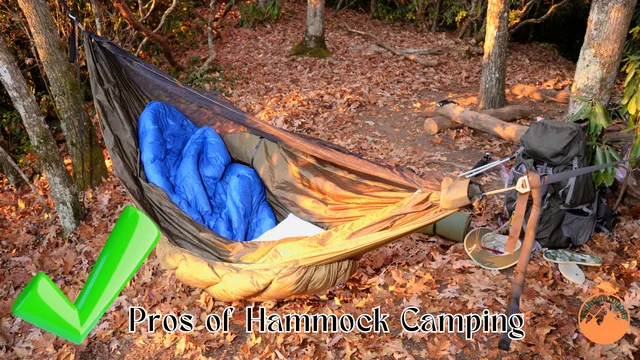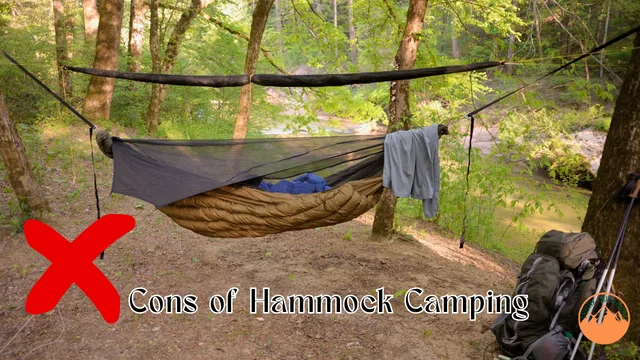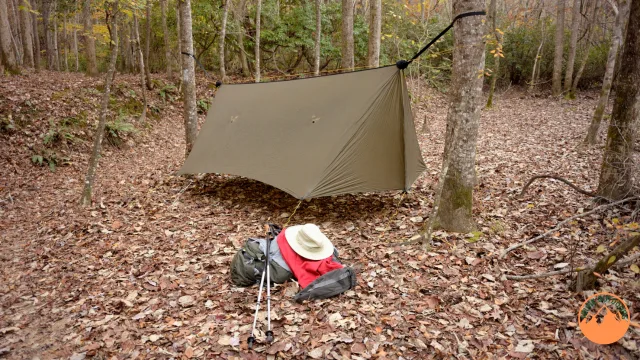Pros and Cons of Hammock Camping: A Comprehensive Guide
Are you tired of sleeping on the ground during camping trips? Do you dread the thought of setting up a tent every time you go on an adventure? If so, hammock might be the solution for you.
As someone who has spent countless nights exploring the great outdoors, I can confidently say that hammock offers a whole new level of comfort, convenience, and versatility, but it also has some drawbacks.
I’ve tried hammock camping firsthand and want to share my insights into the pros and cons of hammock camping to help you decide if it suits your next adventure, along with some tips for maximizing your experience.
The Pros of Hammock Camping
When it comes to the pros of hammock camping, there are several key factors that make it an appealing choice for outdoor enthusiasts like myself.

1. Modularity and Customization
One of the standout advantages of hammock camping is the ability to customize your gear to fit your specific needs.
With hammocks, you have the freedom to choose and combine different components, such as a bug net or tarp, based on the demands of each trip.
This level of modularity ensures that you’re equipped for any situation, whether you’re dealing with pesky insects or unpredictable weather.
2. Easy Packing and Portability
For those who need to pack light and travel efficiently, hammocks are an absolute dream. With their separate components, hammocks can be easily packed into different bags, making them highly portable.
This feature is especially appreciated by bikepackers like Ryan Steger, who value gear that can be conveniently stowed away without adding unnecessary bulk.
3. Versatility as a Chair
Imagine lounging comfortably in nature without the need to carry a separate backpacking chair. Hammocks provide this luxury by doubling as a chair.
Not only does this save valuable weight and space in your backpack, but it also offers an additional spot to relax and soak in the beauty of the outdoors.
4. Usable Space with Tarp
When paired with a tarp, hammocks offer more than just a sleeping solution. With the added coverage of a tarp, you can create a dedicated area for various activities such as cooking, sitting, or storing gear.
This expands the usable space and enhances the overall camping experience, making hammocks a versatile choice for outdoor adventurers.
Related: How To Get In And Out Of A Hammock Safely
5. Adaptability to Terrain
Say goodbye to the hassle of searching for the perfect tent spot that is free of roots, inclines, or other obstacles. Hammocks provide a solution to this problem by being less affected by ground conditions.
Whether you’re hanging over rock outcroppings or tackling challenging terrains, setting up a hammock is a breeze. This adaptability gives you the freedom to choose your camping spot without the limitations imposed by the terrain.
6. Improved Sleep Quality
For those who value a good night’s sleep, hammocks have a clear advantage over tents. When setup correctly, hammocks can provide a sleep experience that surpasses that of traditional tents.
The unique diagonal sleeping position in a hammock cocoons your body, offering optimal comfort and support. This is particularly beneficial for individuals who struggle with back pain or discomfort.
So, if you’re looking for a camping experience that allows you to wake up feeling refreshed and rejuvenated, hammock camping might just be the answer.
Related: Can A Hammock Replace A Bed?
7. Perceived Safety from Wildlife
While the actual safety level may vary from person to person, many campers feel more secure in a hammock compared to sleeping on the ground.
The elevation provided by a hammock can create a perceived barrier between you and local wildlife, making it harder for animals like snakes or critters to reach you.
This added peace of mind can enhance your overall camping experience, allowing you to fully immerse yourself in nature without worries.
8. No Concerns About Ground Conditions
Unlike traditional tent camping, hammock camping eliminates the concerns and hassles associated with ground conditions.
You can confidently set up your hammock over rock outcroppings, uneven terrain, or other challenging surfaces without worries of water pooling, rocks digging into your back, or uncomfortable slopes.
Hammocks offer a comfortable and secure sleeping space that adapts to various terrains, allowing you to focus on enjoying the beauty of the natural world around you.
The Cons of Hammock Camping

1. Cost:
high-quality ultralight hammock gear, such as hammocks, suspension systems, tarps, and other accessories, can be quite expensive.
In fact, the cost of these hammock-specific items can sometimes be comparable to the cost of a traditional ground camping setup, which typically includes a tent, sleeping pad, and sleeping bag.
It’s important to note that the cost of hammock gear can vary greatly depending on the brand, features, and materials used. While there are budget-friendly options available, if you’re looking for ultralight and high-quality hammock gear, it may come with a higher price tag.
When considering the cost of hammock camping, it’s important to factor in the longevity and durability of the gear. Investing in high-quality hammock gear can provide you with long-lasting equipment that will endure many camping trips, whereas cheaper options may need to be replaced more frequently.
Ultimately, the cost of hammock camping is a personal consideration, and it’s important to weigh the potential benefits and drawbacks against your budget and camping preferences.
2. Learning Curve:
This means that there is a certain level of skill and knowledge required to properly set up a hammock for camping.
When you first start using a hammock, it might take some practice and experimentation to understand how to correctly hang and adjust the hammock to achieve the most comfortable and secure setup.
You may need to learn about different suspension systems, tensioning techniques, and finding suitable anchor points such as trees or stands.
It’s common for beginners to need some time to become familiar with these aspects of hammock camping and develop the necessary skills.
Over time, as you gain experience and practice, you will become more proficient at setting up your hammock quickly and efficiently. You will also learn what adjustments and configurations work best for your comfort and support.
Keep in mind that everyone’s learning curve may be different, and it’s normal to encounter some trial and error when initially getting started with hammock camping. With patience and practice, you’ll gradually become more comfortable and confident in your ability to set up and enjoy hammock camping.
Related:
- How To Hang A Camping Hammock In 5 Easy Steps
- How Big Does A Tree Need To Be For A Hammock?
- The Ideal Distance Between Trees For Hammock Camping
3. Can be difficult to stay warm in colder weather
While hammock camping can be great in warm weather, it’s not always the best option in colder weather because hammocks are suspended in the air, they don’t provide the same level of insulation as tents.
You’ll need to bring additional insulation to stay warm such as using an insulated sleeping pad and sleeping bag, which can add weight and take up space in your backpack. You’ll also need to find a way to protect yourself from the wind and rain.
Check out How To Stay Warm Hammock Camping?
4. Limited space for gear and movement
Another challenge of hammock camping is limited space. While hammocks are comfortable and versatile, they don’t provide as much room as a tent.
This can make it difficult to store gear, change clothes, or move around comfortably.
5. May not be suitable for all sleeping positions or preferences
Hammock camping may not be suitable for all sleeping positions or preferences because hammocks have a unique sleeping surface that may not be comfortable for everyone.
Some people may prefer a flatter, more rigid surface to sleep on, and find the curvature of the hammock to be uncomfortable.
Additionally, the slight sway or movement of the hammock while sleeping may take some getting used to for some people.
Read also: Can You Sleep On Your Side In A Hammock?
6. Can be uncomfortable for some people with back or hip issues
Hammock camping can be uncomfortable for some people with back or hip issues[1] because the hammock doesn’t provide a flat sleeping surface, which can put additional pressure on certain areas of the body.
Additionally, some people may find that the curvature of the hammock can cause discomfort in the back or hip area. Restless sleepers may also find it challenging to stay comfortable in a hammock.
The slight sway or movement of the hammock while sleeping may take some getting used to, and it may require adjustments to find a comfortable sleeping position.
By considering these factors, including any back, hip issues, and personal preferences, you can make an informed decision about whether hammock camping is suitable for you.
Read more: Tips For Sleeping In A Camping Hammock
7. Requires appropriate trees or anchors to set up
Hammocks require trees for setup, which can limit their use in treeless landscapes. In areas without suitable trees, finding alternative anchor points may be challenging.
Some campers use hammock stands or any two sturdy objects to hang their hammocks, but these methods have their challenges. Read our guide to hammock camping without trees.
8. May require additional gear for optimal use
Hammock camping may require additional gear such as bug netting, rain fly, or underquilt for optimal use. The hammock itself doesn’t provide any protection from the elements or bugs.
A rain fly is needed to protect the hammock and the camper from rain or snow, ensuring a dry and comfortable camping experience. Additionally, bug netting is necessary to keep insects and bugs away from the camper while they’re sleeping.
Depending on the weather, hammocks may also require additional insulation to ensure comfort and warmth. In colder temperatures, an underquilt or additional insulation may be necessary to stay warm during the night.
Read more: Hammock Camping Must-Haves
Tips for Successful Hammock Camping

- Choose the Right Hammock
Choosing the right hammock is key to a successful hammock camping experience. Look for a hammock that is designed specifically for camping, with features like bug nets, rain flies, and built-in insulation.
Also, it’s important to experiment with different models, setups, and sleeping positions to find what works best for your body and sleeping preferences.
- Bring the Right Gear
In addition to a hammock, you’ll also need to bring the right gear for your trip. This includes an insulated sleeping pad and sleeping bag for cold weather camping, as well as a lightweight backpack and other camping essentials.
For peoples with back or hip issues, try to hang your hammock properly. Also,there are many hammock models with flatter sleeping surfaces, or additional gear such as inflatable sleeping pads can be used for extra support and comfort.
It’s important to find the right setup that works for your own body to ensure a comfortable and restful night’s sleep while hammock camping.
- Find the Right Location
Finding the right location for your hammock is also important. Look for two sturdy anchor points that are at least 12 feet apart, and make sure the area is free from hazards like sharp rocks or branches.
- Practice Setting Up Your Hammock
Before you head out on your camping trip, it’s a good idea to practice setting up your hammock. This will help you identify any issues with your gear and ensure that you can set up your hammock quickly and easily when you reach your campsite.
- Bring a Tarp & bug netting
Bringing a tarp is also a good idea when hammock camping. A tarp can be used to provide extra protection from the rain, and can also be used as a shelter for cooking or relaxing. While a bug netting is necessary to keep insects and bugs away from the camper while they’re sleeping.
Bonus Tips: it’s important to invest in high-quality gear and accessories when planning a hammock camping trip to ensure a safe, comfortable, and enjoyable experience.
- Stay Warm
Staying warm is one of the biggest challenges of hammock camping. To stay warm, make sure you bring an insulated sleeping pad and sleeping bag, and consider using a hammock-specific underquilt to provide additional insulation.
- Consider a Hammock Stand
If you’re camping in an area where there are no trees or other anchor points, a hammock stand can be a great option. Hammock stands are portable and easy to set up, and provide a sturdy anchor point for your hammock.
FAQs about Hammock Camping
-
Can I hammock camp in cold weather?
Yes, you can hammock camp in cold weather, but you’ll need to bring additional insulation like a sleeping pad and underquilt to stay warm.
-
How do I find suitable trees for my hammock?
Look for trees that are at least 12 inches in diameter and spaced 10-12 feet apart. Make sure the trees are healthy and strong enough to support your weight.
-
Do I need a special hammock for hammock camping?
Not necessarily, but it’s recommended to use a hammock designed for camping as it will be more durable and have features like bug nets and rainflys.
-
How do I stay dry in a hammock during rain?
You’ll need to use a rainfly to protect yourself and your gear from the rain. Make sure the rainfly is set up properly and covers the entire hammock.
Conclusion
Hammock camping can be a great alternative to traditional camping, but it’s not for everyone.
It brings a multitude of benefits that elevate your outdoor experience, like comfort, portability, versatility, and ease of packing. but also has limitations like cost, weather restrictions, limited space, and finding suitable trees or abject to hang it.
When choosing a hammock, consider your needs and preferences, as well as factors like durability, cost, and versatility. With the right gear and knowledge, hammock camping can be a fun and enjoyable way to experience the great outdoors.